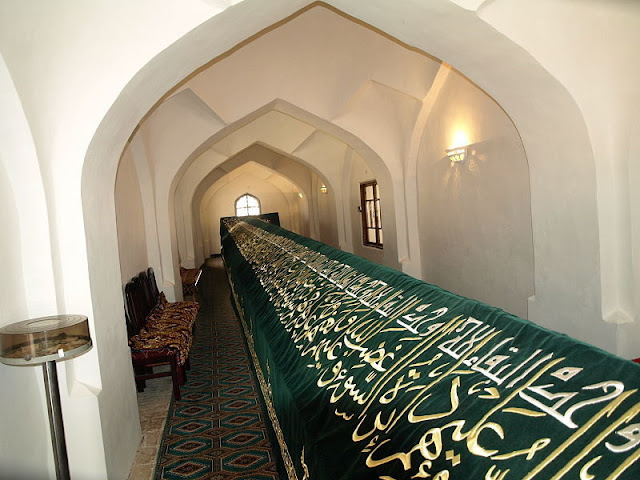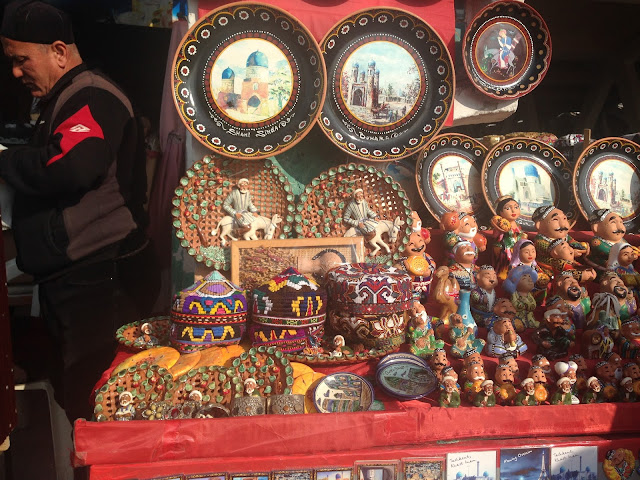Samarkand is a city in Uzbekistan known for its mosques and mausoleums. It's located on the Silk Road, the ancient trade route linking China to the Mediterranean. Prominent landmarks include the Registan, a plaza bordered by 3 ornate, majolica-covered madrassas dating to the 15th and 17th centuries, and Gur-e-Amir, the towering tomb of Timur (Tamerlane), founder of the Timurid Empire
In 1403, 27-year-old grandson of Amir Timur - Mohammed Sultan, who predicted in the heirs to the throne, returning from a trip to the coast of Asia Minor, suddenly dies. The remains of the deceased on the way the prince were taken to Samarkand and buried in the ensemble of structures previously constructed by him, consisting of a madrassa (the oldest madrasah in Central Asia), “khanaka” and minarets.
The Gūr-i Amīr or Guri Amir, is a mausoleum of the Asian conqueror Tamerlane in Samarkand, Uzbekistan
After burying his grandson, Timur ordered to build a mausoleum for the prince. But it works, obviously, have not been brought to fruition, since the beginning of 1405, Timur died and was buried here, although it is known that he had procured a grand mausoleum in his hometown in Shakhrisabz. But the sudden death and the complex political situation that arose after his death, led to the fact that Amir was buried in Samarkand.
Inside the Gur Emir there are eight sarcophagi, seven of marble and one of deepest green jade, the top a single massive slab, that marks the burial place of Temur himself. No bodies lie within them, the actual tombs are in the crypt beneath, simple stone tombstones lying directly in alignment with the grander markers in the hall above.
Buried beside Temur are two of his sons, Ulugh Bek and another grandson and two un-named children. The last tomb is that of Temur's spiritual advisor at whose feet the conqueror wished to lie.
In the tomb and buried two sons of Tamerlane - Miranshoh and Shohruh Mirzo (Ulugbek's father), Ulugbek himself, two young Timurid Abdullah Mirzo and Abdurahmon Mirzo. In the marble wall, on a hill is the gravestone of the Sufi Sayyid Umar. According to one version, it might be, Sheikh Sayyid Mir Kulol - Sufi, who was friends with the Timur’s father - Emir Taragai himself
The hall is beautifully decorated with marble, gold and painted panels above a deep frieze of celadon-coloured onyx tiles. The whole place radiates a solemn dignity and restraint that is very moving.
Outwardly the Gur-Emir Mausoleum is a building with a dome vault. He is known for its simplicity of design and grand monumental architecture. The outer side walls lined with blue, light blue and white tiles. The dome of bright blue with deep sockets and white specks. The diameter of the dome 15 meters and a height of 12.5 meters. Large recesses give the dome an amazing expressiveness.
The Registan was the heart of the ancient city of Samarkand of the Timurid dynasty, now in Uzbekistan. The name Rēgistan (ریگستان) means "Sandy place" or "desert" in Persian.
The Registan was a public square, where people gathered to hear royal proclamations, heralded by blasts on enormous copper pipes called dzharchis - and a place of public executions. It is framed by three madrasahs (Islamic schools) of distinctive Islamic architecture.
The history of the Registan Square
Translated from Uzbek, “registan” means a sand place. In the ancient times, this central square was covered by sand. The territory was not initially surrounded by madrassah; those great erections appeared rather later. In that period, authorities of the city were gathering people on the square to announce khan’s orders, held celebrations and public executions, and collected the army leaving to war.
In the past, one could see many trade rows around the square, where artisans and farmers were selling their goods. All main roads of Samarkand led to Registan where it was always noisy and lively.
Various rulers during their reign would change the main significance of the square, but since those times and up to now, Registan has always been the center of the city social life.
There are three madrassahs on the square: Ulughbek, Sherdor and Tilla-Kori, that are the main sights of the city. They were erected by two rulers at different times.
Mausoleum of Imam al-Bukhar
The mausoleum of Imam al-Bukhari in Samarkand is a very impressive sight. It is is a masterpiece of modern Uzbek architecture based on traditional oriental style. When you enter through a huge gate, you will immediately step into the courtyard laden with lavish lawns, tall trees and colourful flowers and on the left is the ablution area and Masjid.
The mausoleum of Imam al-Bukhari lies straight ahead. Imam al-Bukhari Mausoleum LocationInside the mausoleum of Imam al-Bukhari there is a marble tomb, but the real burial site of Imam al-Bukhari is actually below that tomb. The mausoleum is topped by a small dome that is raised upon marble columns shining in the effective light. The rectangular tomb is cased in polished marble of many colours, and before it is the gravestone, the lines of Arabic written upon it briefly summarizing the Imam’s life.
Abu Abdullah Muhammad ibn Ismail al-Bukhari - the famous theologian, the hadith collector (Hadith - the science of Hadith, reports about the sayings and deeds of Prophet Muhammad) and the author of the second most important book of the Muslims after the Koran "Al-Jomiy al-Saheeh" ("Secure book ").
Mausoleum of St. Daniel in Samarkand
On the shore of Siab, a small tributary of Zerafshan River, there is a sacred place, which keeps the relics of Daniel, the Old Testament Biblical Prophet. Another version says that there are the relics of Daniyol (or Danier), an associate of the Arab preacher Kussama ibn Abbas. But all versions agree that Danier is the Saint and pilgrims from all the three world religions come here to worship him.
It is considered that the spirit of buried Saint protects Samarkand, brings wealth and prosperity to its people. Believers come here to pray near the mausoleum. Especially pilgrims worship the spring near the mausoleum.























































